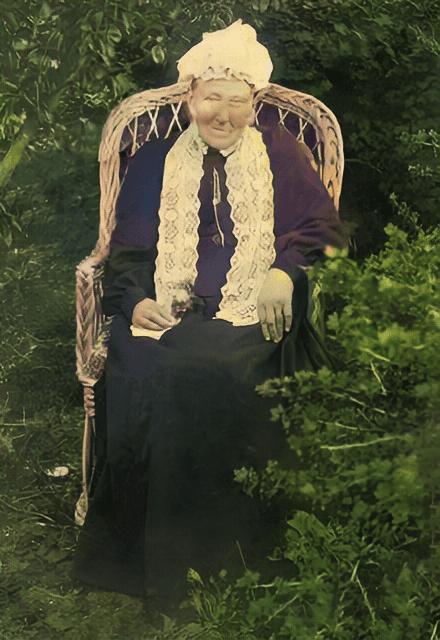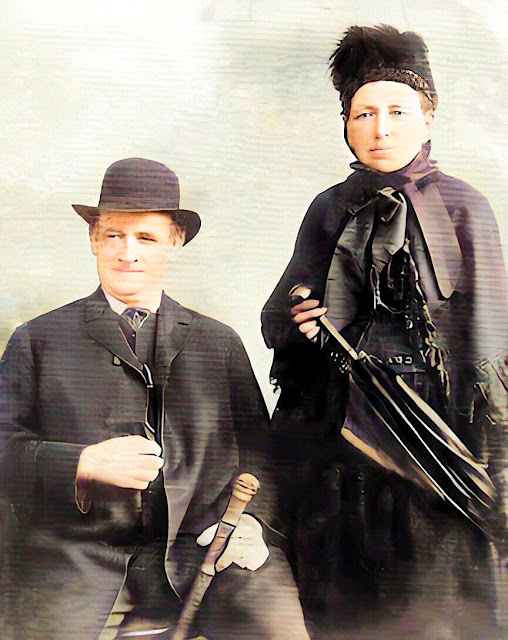Born in Bridge Street in 1825, Martha was one of William Pettit's and Martha Hull's four children. In 1919 a daughter called Martha died within a year. At a time of high infant mortality, it was not uncommon for the next son or daughter to be given the same name.
Martha's father died in 1839. In 1841 the family lived in the Bullock Market, today the Broadway. Martha's mother was a schoolmistress. Martha, aged 15 years, was a dressmaker. They shared the accommodation with two other families.
In Hemingford Grey lived Frederick Underwood, pictured above with Martha. Frederick followed his father's occupation as a tailor. Frederick and Martha married in 1844.
In 1851 Martha and Frederick lived at 23 Orchard Street, Cambridge, from where Frederick ran his tailoring business employing an apprentice. They had four children, the latest 4 months old.
By 1861 the family had grown to 8 children, the youngest 10 months old. Frederick was a master tailor, Martha a tailoress. Their oldest son was an apprentice tailor.
Frederick was bankrupt in 1868. This prompted a move to London. In 1871 they lived at 2 Crown Court, Pall Mall, London, a narrow alley just off St James's Street. A further three children had been born.
In September 1873 Martha, Frederick and nine of their children left Gravesend with 262 other passengers aboard the Surat, bound for Dunedin, New Zealand. Having weathered the three month journey, on 31 December 1873 the ship rounded the southern end of South Island, New Zealand. When the Surat hit a submerged rock, most passengers were asleep. Soon the deck was full of anxious men, women and children, many in their nightclothes.
 |
| The Surat, 1863. |
Initially the crew found only minor damage. During the night a weakened section of the hull gave way. The ship took in water. Everyone took turns desperately manning the pumps to keep the ship afloat.
They sighted a vessel at daylight which offered help. The passengers almost rioted when Captain Johnson, in charge of the Surat and reportedly drunk, refused assistance. Salvage rules entitle a rescuer to payment, something the Captain wished to avoid. He produced a revolver and threatened to shoot anyone defying his orders. Anchoring in a nearby bay, the Captain landed half the passengers. In danger of floundering, the Surat was beached after struggling on to another bay. All the remaining passengers and crew landed safely.
The passengers completed their trip to Dunedin aboard another ship. Their belongings were ruined, left behind in the Surat. Their only possessions were the clothes they wore. Dunedin residents gave succor and set up an emergency fund. The hospital tended several passengers suffering from exposure.
Frederick accepted an offer of work from Daniel Haynes, a Dunedin philanthropist and partner in the large drapery firm of Herbert, Haynes and Hay. Soon they moved to Oamaru, 70 miles north of Dunedin, where Frederick worked as a tailor for twelve years.
New Zealanders call the 1880s the long depression. Conditions hardened and jobs were in short supply. Many New Zealanders left for Australia. In 1884 Frederick and Martha, both aged 60 years, emigrated to Sydney, Australia, with their three youngest children, Walter, Herbert and Robert. They lived in Crown Street, where Frederick ran a tailor's shop.
 |
| Martha Underwood, Oamaru c1912. |
Frederick died in 1898 aged 73 years. Martha returned to Oamaru, New Zealand, to be with her daughters, living with Emily. Martha died in 1912 aged 86 years and is buried at Oamaru Old Cemetery. The Otago Witness published Martha's obituary.
To read more about St Ivians who settled worldwide, click Emigrants.



No comments:
Post a Comment